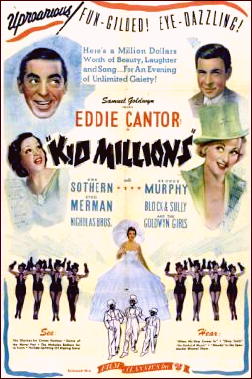September 2011
Monthly Archive
Wed 14 Sep 2011
Posted by Steve under
Reviews[2] Comments
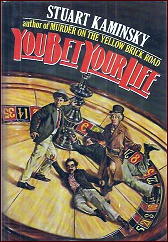
STUART KAMINSKY – You Bet Your Life. St. Martin’s, hardcover, 1978. Paperback reprints: Charter Book, 1980; Mysterious Press, 1990.
Hollywood private eye Toby Peters, whose previous clients have included the likes of Errol Flynn and Judy Garland, now heads for Chicago, to settle some gambling debts that Chico Marx strongly protests are not his.
The inclusion of an aging Al Capone and a youthful Richard Daley in walk-on roles, as well as some other pleasurable surprises, continues to make this series a boisterously welcome romp in nostalgia, but like a good many pulp stories of the same era, the detective story involved relies far too heavily on far too many complications. Not quite hidden is the fact that the plot makes little or no sense at all.
Next, however, an urgent job for Howard Hughes.
Rating: C.
— Reprinted from The MYSTERY FANcier, Vol. 3, No. 6, Nov/Dec 1979. This review also appeared earlier in the Hartford Courant.
[UPDATE] 09-14-11. This was the third in a series of 24 recorded Toby Peters adventures. There’s no doubting the popularity of the character, and one of the reasons has to be sheer nostalgia. The clients he has and characters he meets while tackling their cases, mostly real-life movie stars but loads of other famous personalities of the 1940s as well, are guaranteed to catch any would-be reader’s eye.
While I no longer recall the details of this one, the weaknesses of the plots in general are what I do remember. I read a lot of the books in the series, though, so I must not have minded too much!
Tue 13 Sep 2011
THE CASES OF EDDIE DRAKE PART THREE:
THE PALEY CENTER JOINS THE FUN
by Michael Shonk
Before beginning, you may wish to go back to the first two in this series of articles about one of the more mysterious private eye series in early TV, The Cases of Eddie Drake. Part One is here, and Part Two followed soon thereafter.
After these two posts appeared, I asked various archives for information about the series. David Bushman of the Paley Center for Media Arts responded they had nine episodes and offered me the chance to watch them. To this old researcher it was like getting a free ticket to Disneyland, but I was unable to go. Mr. Bushman asked me to send in my questions and someone there would watch the episodes and try to find some answers.
I am amazed by the effort Mr. Bushman and the Paley Center put into answering questions about a show few remember and even fewer care about. If you have any interest in saving old television I can’t think of a better place to support or be a member. Please, check out their website at PaleyCenter.org.
The episodes were in no condition to view, so techs at the Paley Center have been hard at work making viewable digital copies. This done, Mr. Bushman watched the following episodes: “The Brass Key” (episode one), “Hush, Hush”, “Murder By Proxy”, “Murder in Three-Quarter Time”, “Sleep Well, Angel”, “The Judas Coin”, and “A Hole in the Head” (all with Patricia Morison). He also watched “Murder Ad Lib” and “The Man Who Was Nobody” (with Lynne Roberts).
With “Shooting The Works” (new link), this leaves only three episodes still missing.
While the question of when did Eddie Drake first air remains unknown, we have learned more about the series.
Copyright date on the Patricia Morison’s episodes is 1948. The copyright on the Lynne Roberts’ episodes is 1951. Copyright holder for both is IMPPRO. There is no mention on copyright screen of CBS, DuMont, or NBC.
“Were there any changes to the standing sets? Was Eddie’s rare 1948 Davis Divan in all episodes?” It is unlikely the sets for a series shelved for three years would have survived.
Eddie’s rare car was in all the episodes except the first “The Brass Key”. This makes “Shooting the Works” episode two since Eddie mentions he has bought a new car.
Amazingly, Mr. Bushman took the time out to map Eddie’s office in Morison and Roberts’ episodes. The water cooler, the map, the window with the fake brick wall showing through, the bookshelf, and the rest were the same. The most noticeable change was the set looks better in the Roberts’ episodes.
There were differences. The theme song and opening credits changed. Roberts’ episodes had a fancier title card featuring a full body silhouette of a man in a suit (drawing) in lower right corner of the screen his shadow cast under the letters of the title.
Morison’s episodes had her and Haggerty deliver the credits at the end, while Roberts’ episodes credits were graphics upfront.
“Any changes in the credits?” The chances the exact same people would return after three years is unbelievable.
The same people but with newly credited help. Jason James wrote all episodes seen, but the Roberts’ two had an additional credit for additional dialog by Robert Lehman. Harlan Thompson and Herbert Strock produced all episodes with Paul Garrison directing, Morison’s episodes had photography by Guy Roe OR Charles Trego. Roberts’ episodes had photography by Guy Roe and Lucien Androit. Strock was credited alone in the Morison’s episodes while he AND Ed Taylor got screen credit in the Roberts’ episodes. Assistant director was Leo Pepin then Leo Peppin (unknown why he added another p to his name) and Chuck Wasserman.
“Any differences in the two female characters?”
Both were psychiatrists. There is no mention of Dr. Gayle (Morison) or the book in the two Roberts’ episodes seen. The relationship between Drake and the two remains much the same. Cop Lt. Walsh is played by Theodore von Eltz in all episodes.
So what have we learned? For one, a major clue in the Producer credits.
Searching Billboard (at Google books), the August 13, 1949 issue, regarding the Ed Wynn Show for CBS, there was this: “Harlan Thompson named yesterday (6) as show’s associate producer. Thompson is a former veepee of IMPRRO (sic) Inc with film and Broadway musical comedy production experience.”
IMPPRO was still in production in 1952, but without Harlan Thompson. Herbert L. Strock was now President of the company.
If IMPPRO, the copyright holder, was still active, why would DuMont need to film the final four episodes? If DuMont did film the final four (as is currently believed), why were the thirteen episodes shown on WENR-TV starting September 7, 1951 when DuMont did not air Eddie Drake until March 6, 1952? If filmed in 1951, why is Harlan Thompson credited as producer when he left the company before August 1949?
Now what do we know and what can we deduce?
Billboard magazine from 1948 reported five episodes of Eddie Drake were delivered to CBS, with four more in editing. The filming of the final four episodes was scheduled for November 17, 1948.
Suddenly, Patricia Morison was offered the lead in Broadway play Kiss Me, Kate. She is gone. Deduction: This is why IMPPRO had to recast the part for the final four episodes to complete the order CBS had paid $300,000 for.
Current belief says CBS tossed the nine and never aired them. Why? $300,000 in 1948 is a great deal of money to just toss away. And why copyright the episodes in 1948?
If so many confirmed clues point to the final four being filmed in 1948-49, why are those episodes copyrighted 1951?
How the Sherlock Holmes do I know? But I can guess.
The improved look of the series probably came from a sudden increase in the budget. Where did IMPPRO get the money?
During the delay to recast, did CBS TV Film Sales copyright and shop the nine episodes around? Was the early sales of the first nine episodes where IMPPRO got the money to increase the budget?
But if the Roberts’ episodes were filmed in 1948-49, why weren’t they copyrighted then?
Deduction: something went wrong. Perhaps the sales were not good enough for CBS, so it didn’t bother to copyright the final four and shelved the entire series.
Until 1951 when there was a growing demand for TV Film syndicated series. CBS dusted off Cases of Eddie Drake, copyrighted the Roberts’ episodes, and sold them in syndication.
I remain convinced Eddie was on the air somewhere in 1949, but until I can prove it:
THE CASES OF EDDIE DRAKE (Syndicated) 1951. Created and written by Jason James. With additional dialog for few episodes by Robert Lehman. Produced by Harlan Thompson and Herbert L. Strock. Directed by Paul Garrison.
Sun 11 Sep 2011
Posted by Steve under
Reviews[8] Comments
REVIEWED BY BARRY GARDNER:
ROBERT J. RANDISI – Hard Look. Miles Jacoby #5. Walker, hardcover, May 1993. No paperback edition.

Miles Jacoby owns a bar, now, after the death of his friend Packy, who willed it to him. He’s still a PI, though, and heads to Florida when a man shows him a postcard with the rear view of a fit and attractive young woman, and says it’s his missing wife.
The Mets are out of the playoffs, so why not? Then a man he had spotted following him in New York turns up dead in Tampa — in Jacoby’s hotel room. The ops are unhappy, ans so is Jacoby. Obviously, there’s a bit more to the case than a missing wife.
Randisi is getting better and more assured with his writing in each book. I haven’t liked the Jacoby books as well as the Brooklyn series with Nick Delvecchio, but I enjoyed this one considerably.
Randisi’s strengths are the likability of his characters and a very smooth narrative flow. The overall plot wasn’t bad, but I wish Randisi — and a number of other PI writers — would quit working cops into their stories in totally unrealistic ways.
Here, Jacoby and a cute, young, female Deputy hit it off rather well, and she chases around with him the rest of the book, flashing her badge at appropriate times to help him out. Bullshit. It’s just lazy plotting, and he’s better than that.
— Reprinted from Ah, Sweet Mysteries #8, July 1993.
Sun 11 Sep 2011
Posted by Steve under
Reviews1 Comment
A REVIEW BY RAY O’LEARY:
LAWRENCE BLOCK – Out on the Cutting Edge. William Morrow, hardcover, October 1989. Avon, paperback, October 1990.
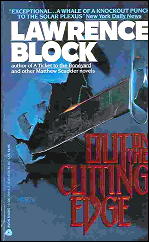
Alcoholic ex-cop and unlicensed private detective Matt Scudder is hired by an Indiana businessman, Warren Hoeldtke, to look for his daughter Paula who came to New York trying to break into show business but hasn’t contacted her family for the past several months.
Meanwhile, Matt has become friendly with a small time ex-con named Eddie Dunphy, who has been attending A.A. meetings for the past seven months and is mulling over asking Matt to be his “confessor” in Step 5 of the Alcoholics Anonymous program.
Eddie claims to have something pretty heavy on his mind and when he doesn’t show up at meetings for a few days Matt manages to get into his apartment and discovers Eddie’s body. Eddie, apparently, had strangled himself while experimenting in kinky sex. Matt, naturally, thinks there is something fishy about the death.
While I fully expected the two cases to connect up, I was somewhat surprised that they did only tangentially. (While looking into one case Matt discovers what happened in the other.) The characterization is excellent: Eddie; the woman who manages Eddie’s building, Willa Rossiter, with whom Scudder begins a sexual relationship; and a West side hood named Mickey Ballou.
My main quibble with the book is the hurried ending. Having discovered what happened to Paula, Matt does a few hours of telephoning and record checking and suddenly knows who killed Eddie and why.
Sun 11 Sep 2011
Posted by Steve under
ReviewsNo Comments
REVIEWED BY STAN BURNS:
WILLIAM KENT KRUEGER – Vermilion Drift. Atria Books, hardcover, September 2010; trade paperback, June 2011.
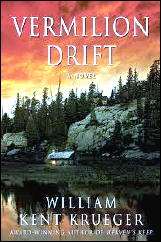
A year after the death of his wife, Cork O’Connor has started a “confidential investigation and security consulting business.” He is hired by Max Cavanaugh, the owner of the Great North Mining Company, to investigate the disappearance of his sister Lauren.
At the same time he is looking into who is sending threatening letters to those involved in a government investigation of the company’s shuttered Vermilion One iron mine as a possible place for long term storage of radioactive waste, which many locals violently oppose.
When Cork is called upon to enter the mine to look at graffiti deep inside with the same threatening message, he figures there must be another entrance to the mine. While exploring a walled out passage that is marked on maps as a collapse, he discovers that it is still a viable passage, and exploring down the passage he stumbles on a side cavern that contains the remains of six victims — one recent and five older.
The recent victim turns out to be the missing sister, but the others are half a century old, and may be the remains of “the Vanishings” — three Indian girls who disappeared in the summer of 1964, when Cork’s father was sheriff. Further investigation reveals that one of the Indian woman victims has a bullet lodged in her spine, and that the same gun used in that fifty year old killing was used to kill Lauren.
And what may that have to do with the reoccurring nightmares Cook is having about being responsible for his father’s death? This reminds me a lot of the style of a Ross MacDonald novel — where past violence has led to tragedy in the present. The novel starts rather slowly, but about 100 pages in it turns into a compulsive page turner. Not as good as Heaven’s Keep, the previous novel in the series — this is number ten — but still a satisfying read.
Rating: B.
Sun 11 Sep 2011
Posted by Steve under
Reviews[3] Comments
IT IS PURELY MY OPINION
Reviews by L. J. Roberts
S. J. ROZAN – On the Line. St. Martin’s, hardcover, September 2010. Trade paperback: August 2011.
Genre: Private Eye. Leading characters: Bill Smith & Lydia Chin (10th in series). Setting: New York City.
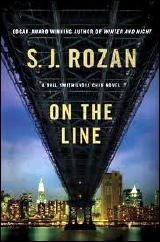
First Sentence: Crashing dark chords smothered the cell phone’s impertinent chirp, but the ringtone was “Ride of the Valkyries,” so it penetrated, and I stopped.
PI Lydia Chin has been kidnapped. Her sometimes partner and friend who wishes he were more, has 12 hours before the kidnapper will kill Lydia. Bill Smith is led on a desperate chase through New York City following obscure clues and being chased by the police who set it up to appear Bill murdered a Chinese prostitute.
He is also slowed down by the Chinese criminal who believes the same thing. Fortunately, Bill does have the help of Lydia’s techno-whiz cousin, Linus, his girlfriend Trella, and Lydia’s best friend, Detective Mary Kee.
Let me start by declaring myself to normally being a huge fan of S.J. Rozan. However, I shall admit, this book let me down.
Those of us who follow the series knew it was Bill’s turn to take the lead and there were some interesting supporting characters, particularly Linus and Trella. One of the most delightful characters of the series was completely missing from the story, however, except in reference.
However, my biggest issue with the book overall had to do with characters. There was no character development. Once again, an author based the book on the assumption that readers had read previous books in the series, which I feel is such a mistake.
The entire premise of the story is built on Bill’s search for Lydia yet there is little explanation, beyond the fact they are occasional partners, giving a new reader an understanding of the real depth of the relationships. This is true of all the relationships; what background is given is glancing at best.
The story is fully plot driven. It starts off high energy and, with a 12-hour clock running, never takes a break. It is exciting and suspenseful but almost too much so. The technological information is fascinating but did seem a bit too easy.
The very clever use of Twitter and Facebook demonstrates just how powerful and ubiquitous they have become and how hard it can be for those not technology-focused to be left behind the curve. However, the ease and speed at which much of the information Bill and his team were able to obtain did stretch credulity quite a bit.
Having read all of Ms. Rozan’s books, I know how good her writing can be. I can understand an author wanting to try something new, but this almost had an action comic feel about it. If you’re looking for a non-stop, beat-the-clock, distracting airplane book to leave behind at the end of the trip, this would satisfy that need.
For me, I shall hope Ms. Rozan returns to the quality of some of her previous books for her next one.
Rating: Okay.
Sat 10 Sep 2011
REVIEWED BY WALTER ALBERT:
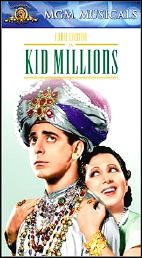
KID MILLIONS. United Artists, 1934. Eddie Cantor, Ann Sothern, Ethel Merman, George Murphy, Berton Churchill, Warren Hymer, Paul Harvey, Jesse Block, Eve Sully, Stanley Fields, Edgar Kennedy, The Nicholas Brothers, Noble Johnson, Clarence Muse. Original screenplay and story by Arthur Sheeman, Nat Perrin, and Nunnally Johnson; photography by Ray June; color photography by Ray Rennahan; music by Alfred Newman; musical numbers directed by Seymour Felix; “Mandy” music and lyrics by Irving Berlin; additional music and lyrics by Walter Donaldson and Gus Kahn, Burton Lane and Harold Adamson. Director: Roy Del Ruth, with the Technicolor sequence directed by William (“Willy”) Pogany. Shown at Cinevent 40, Columbus OH, May 2008.
I had already seen most of the Cantor Goldwyn musicals (of which Roman Scandals has long been one of my favorite ’30s musicals), but Kid Millions, the last of the films under Cantor’s contract with Goldwyn, had eluded me and I was determined to watch it, even if it was shown last on the program at the end of a long day.
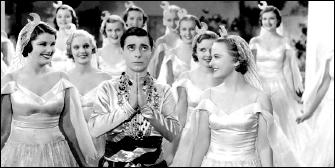
The film was probably not the best of the Cantor musicals, but it was certainly the feature-length film that I enjoyed the most. Busby Berkeley’s inventive staging of the musical numbers, a highlight of the earlier Cantor films, was sorely missed (Seymour Felix was a workmanlike but uninspired replacement), but apart from the major production number (which featured “I Want To Be a Minstrel Man,” “My Head on Your Shoulder,” and “Mandy” and was only rescued from mediocrity by the sensational dancing of the Nicholas Brothers), the songs, mostly integrated into the plot, were effectively performed by Cantor, Merman, Sothern, and Murphy.
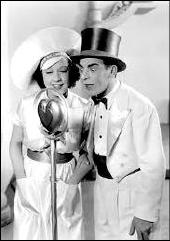
The opening number sung by Ethel Merman (“An Earful of Music”) and an ensemble comic number (“Let My People Go”) were probably the musical highlights. And then there was the technicolor finale, designed by the enormously talented book and magazine illustrator, as well as film production designer, Willy Pogany.
This was a riot of color, a fantasy in which Cantor, finally coming into the fortune left to him by his father, presides over an ice cream feast for a horde of children, in a factory setting that is as much a feast for the eye as the ice cream is for the children. It should be noted that this sequence precedes the first all Technicolor film Becky Sharp that was released some months after the Cantor film, in 1935, and for sheer opulence surpasses the use of color in the prints I have seen of Becky Sharp. The sequence may not be tasteful but it’s eye-popping gorgeous.
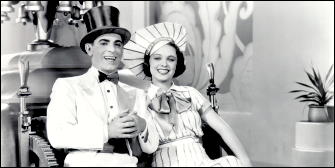
I bought a copy of a laser disc of the film in the dealers’ room on Sunday and copied it to DVD. Now you can all wait for the commercial release on DVD to see if you can experience the rush that I did at the late evening screening.
Editorial Comment: Kid Millions was released on VHS and can be obtained without much difficulty, but the only DVD release seems to be out of print and hard to find. In the meantime, perhaps this color clip on YouTube will suffice, the last seven minutes of the film.
Fri 9 Sep 2011
THE BACKWARD REVIEWER
William F. Deeck
C. ST. JOHN SPRIGG – Death of an Airman. Doubleday Crime Club, hardcover, 1935. First published in the UK: Hutchinson, hardcover, 1934.
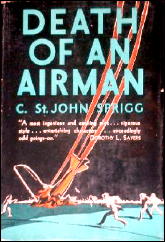
Fortunate it is for the minions of the law that Edwin Marriott, Bishop of Cootamundra, Australia, is in England on leave and wants to learn how to fly. For it is he who spots an anomaly when the flight school’s principal instructor expires after his plane crash: rigor mortis never sets in.
A delayed post-mortem uncovers a bullet wound in the dead man’s head. It can’t be suicide. It also cannot be murder since the pilot was flying alone and no other plane was seen in the area.
Scotland Yard Inspector Bernard Bray, one of Sprigg’s continuing characters, is called in to assist in the investigation. Even he can’t puzzle out the absence of rigor in the corpse, though he does get on the trail of drug smugglers and peddlers (yes, young people, like sex, this was not something invented in your generation).
With the help of the Bishop, Bray and the locals break up the drug ring and finally figure out how the deceased pilot met his fate in an entertaining novel that provides some interesting information about the early days of flying.
— From The MYSTERY FANcier, Vol. 12, No. 3, Summer 1990.
BIBLIOGRAPHY: [Taken from the Revised Crime Fiction IV, by Allen J. Hubin.]
SPRIGG, C(hristopher) ST. JOHN. 1907-1937.
Crime in Kensington (n.) Eldon 1933 [Insp. Bernard Bray; Charles Venables] US title: Pass the Body. Dial, 1933.
Fatality in Fleet Street (n.) Eldon 1933 [Charles Venables] No US edition.
Death of an Airman (n.) Hutchinson 1934 [Insp. Bernard Bray]
The Perfect Alibi (n.) Eldon 1934 [Charles Venables; Insp. Bernard Bray]
The Corpse with the Sunburnt Face (n.) Nelson 1935. US title: The Corpse with the Sunburned Face. Doubleday, 1935.
Death of a Queen (n.) Nelson 1935 [Charles Venables] No US edition.
The Six Queer Things (n.) Jenkins 1937.
Editorial Comments: There is a longer biography of Sprigg on the Golden Age of Detection Wiki, along with a photo.
A challenge I might present to you I’m sure I would win is to have you collect all of the books above, or try to. I do not believe you could do it. If you have a collection already, you must have put it together some 40 years ago or more. At one time the US editions of his books were relatively common, but no more, especially in jacket. (The one shown above came from a Sun Dial reprint.)
As to this particular book, I’ve had a copy since forever, but I’ve never read it. I do wish that Bill Deeck had commented on how clever the “impossible crime” aspect was. At the moment, all it is is a tease.
Fri 9 Sep 2011
Posted by Steve under
General1 Comment
If you ever get tired of reading about mysteries, old movies and old TV shows (and some new ones too), could I make a couple of suggestions?
My daughter Sarah’s blog, Reading the Past, focuses on Historical Fiction, with loads of penetrating reviews, insightful interviews, and previews of forthcoming books, lots and lots of them.
And my son Jonathan has a new website, Financial Review of Books, which is exactly as it says. If you’re interested in up to date discussions of derivatives, economic theory, tax policy and the world of finance, his site is the place to go.
Thu 8 Sep 2011
PRIME TIME SUSPECTS
by TISE VAHIMAGI
Part 6: The Black Mask Brotherhood
The chances are that the 1957 to 1961 TV phase of the American Private Eye will be remembered as the most slickest in the TV genre. (“Slick,” as in the sense of smooth and efficient, streamlined.) There had been nothing else like before and nothing since has managed to equal the quintessence of its visual style.
In short, it was a curious phenomenon seemingly belonging to time, by way of inspiration, aided and abetted by style. This unique time period ranges from, say, Richard Diamond, Private Detective (CBS, 1957-59; NBC, 1959-60) to Michael Shayne (NBC, 1960-61). Fortunately, the phase didn’t last long enough to become a parody of itself (unlike the later TV Spy cycle) and remains therefore a largely unblemished sub-genre.
Hollywood films of the 1940s such as the obvious contenders The Maltese Falcon (1941), the 20th Fox “Michael Shayne” films with Lloyd Nolan (1940 to 1942), Murder My Sweet (1944) and The Big Sleep (1946), featuring private detectives, and fashionably now termed as film noir, had as their inspiration the modern literary genre: from early hard-boiled works by Hammett and Carroll John Daly to more contemporary authors such as Jonathan Latimer, Brett Halliday [Davis Dresser] and Chandler. All except Latimer had been contributors to the pulp magazines (Black Mask, Dime Detective, Spicy Mystery, Thrilling Detective, etc.).
This Hollywood studio period embodied the on-screen noir tough guy, epitomized by a Humphrey Bogart or by an unlikely Dick Powell (Cornered, 1945). They were tense and tight-lipped, yet agile. Men of a cynical disbelief that slipped easily into bemused irony. Their film world was often corpse-littered and bafflingly plotted.
The early period of TV Private Eyes (around 1949 to 1954) tended to stem from radio or were under the executive thumb of proprietorial sponsors. One of the earliest series was Martin Kane, Private Eye (NBC, 1949-54), which seemed to change its leading actor with each season. Charlie Wild, Private Detective (CBS, 1950-51; ABC, 1951-52; DuMont, 1952) was an extension of sponsor Wildroot Cream’s The Adventures of Sam Spade, Detective radio series (Howard Duff).
The Cases of Eddie Drake (DuMont, 1952) was followed by The Files of Jeffrey Jones (syndicated 1954-55); Don Haggerty played the featured PI in each. Disappointingly, these on-screen characters and their milieu belonged strictly to 1940s Hollywood.
The TV Private Eye phase of the late 1950s, on the other hand, appeared to be the result of several exciting events. Primarily, the advent of paperback priginals led by Fawcett’s line of Gold Medal books in 1950 (previously, paperback books had been reprints of hard cover editions). Genre authors published by Gold Medal in the 1950s or its companion imprint, Crest, included Richard S. Prather (with the Shell Scott novels), William Campbell Gault (Joe Puma novels), Stephen Marlowe (Chester Drum novels), Curt Cannon [Evan Hunter] (Cannon/Matt Cordell stories).
Additionally, Henry Kane for Avon & Signet Signet & Avon (Peter Chambers), Thomas B. Dewey for Dell (Pete Scofield) and Frank Kane also for Dell (Johnny Liddell). Reprinted from hardcover were Mickey Spillane for Dutton then Signet (Mike Hammer, of course), a publishing phenomenon, and Brett Halliday for Dodd Mead and Dell (Mike Shayne). Hard-boiled private eye stories seemed to be flavor of the month (or should I say, decade?).
Another strong influence appeared to be the increasing sophistication of jazz music and the contemporary jazz musicians’ sartorial inclination toward what was known as the Ivy League Look (think jazz saxophonist Gerry Mulligan or Craig Stevens in the 1958-61 Peter Gunn or even Dick Van Dyke in the 1961-66 sitcom The Dick Van Dyke Show).
Collegiate, soft-shouldered suits with button-down shirts and slim ties. Rather timely, for four albums which are now considered seminal jazz records (Dave Brubeck’s Time Out, Miles Davis’s Kind of Blue, Charles Mingus’s Mingus Ah Um and Ornette Coleman’s The Shape of Jazz to Come) were all released in 1959.
I remember reading somewhere that the tough-as-nails TV Western hero evolved from his place on the prairie to the mean streets of the TV Private Eye. Interestingly, the Private Eye phase was active during the time of the TV Western stampede (where kiddie actioners like The Lone Ranger and The Gene Autry Show gave way to “adult” Westerns like Cheyenne, Rawhide and Gunsmoke in the mid-1950s).
For me, Scott Brady’s Shotgun Slade (syndicated 1959-61) may have been enjoyable for its account of a gun-toting investigator in the Old West — complete with jazz score! — but I am not at all sure about the theory that Jim Hardie (Tales of Wells Fargo), for instance, might have become someone like Stuart Bailey (77 Sunset Strip).
A listing of relevant TV Private Eye series during this period would include The Investigator (NBC, 1958), Markham (CBS, 1959-60), 21 Beacon Street (NBC, 1959; ABC, 1959-60), Coronado 9 (syndicated 1960-61), Bourbon Street Beat (ABC, 1959-60), Hawaiian Eye (ABC, 1959-63), Philip Marlowe (ABC, 1959-60), Johnny Midnight (syndicated 1960), Surfside 6 (ABC, 1960-62), The Brothers Brannagan (sic) (syndicated 1960-61) and Michael Shayne (NBC, 1960-61).
Some interesting-sounding pilot shows from the decade include “The Girl from Kansas” (1952) with Barry Sullivan as sleuth Nemo Grey (I can’t tell if the would-be series, to be called Nemo Grey, would be about a police or private detective); “Death the Hard Way” (1954) had William Gargan as PI Barry Craig (directed by Blake Edwards); “Mike Hammer” (1954) was an early try-out starring Brian Keith (written and directed by Blake Edwards); “The Bigger They Come” (1955) from A.A. Fair/Erle Stanley Gardner’s first Cool and Lam novel; “Man On a Raft” (1958) had Mark Stevens as Michael Shayne in an early attempt for a series; “The Silent Kill” (1959) was based on author William Campbell Gault’s Brock Callahan p.i. character.
I left my personal favorites until last. The phase included also the bloodthirsty Mickey Spillane’s Mike Hammer (syndicated 1958-59) with a suitably brutal, street-fighting, crew-cutted Darren McGavin (and yes, the author’s and character’s names together is the full title). The enterprising (answering service/car phone) Richard Diamond, Private Detective (CBS, 1957-59; NBC, 1959-60) with the always-watchable David Janssen (his first series) and an outstanding jazz score by Pete Rugolo.
Perhaps the best of the Warner Brothers TV private eye shows of the time, 77 Sunset Strip (ABC, 1958-64) was the first to offer an agency-based ensemble private detective team as well as a snappy signature tune. Blake Edwards’ Peter Gunn (NBC, 1958-60; ABC, 1960-61) stands as the epitome of late 1950s TV Private Eyes for me, dealing out action and sophistication in equal doses, along with Henry Mancini’s entirely jazz-based score.
The latter presentation went on to influence many other TV shows, most notably Staccato (aka Johnny Staccato; NBC, 1959-60; ABC, 1960), John Cassavetes’ gift to the small-screen as jazz pianist/private eye working out of a small Greenwich Village jazz club, often accompanying house band musicians Barney Kessel, Shelly Manne, Red Norvo and Red Mitchell.
They were all were taut crime dramas which if anything improved as they went on. The writing and direction was efficient, being vigorous and well-staged despite some unavoidable weaknesses in plotting and performance. The 1950s private eyes were indeed masterful but mannered heroes. By contrast, later makers of TV Private Eye series seemed to suffer from that garish and nervous over-sophistication which bedevilled so many producers in the age of color television.
A significant TV phase of the past that was sadly brought to a halt by two unrelated forces — the Federal Communications Commission (FCC) and the 1960s TV Spy craze — was the TV Gangster period, led by Quinn Martin’s The Untouchables (ABC, 1959-63). It’ll be my next project.
Note: The introduction to this series of columns by Tise Vahimagi on TV mysteries and crime shows may be found here, followed by:
Part 1: Basic Characteristics (A Swift Overview)
Part 2.0: Evolution of the TV Genre (UK)
Part 2.1: Evolution of the TV Genre (US)
Part 3.0: Cold War Adventurers (The First Spy Cycle)
Part 3.1: Adventurers (Sleuths Without Portfolio).
Part 4.0: Themes and Strands (1950s Police Dramas).
Part 4.1: Themes and Strands (Durbridge Cliffhangers)
Part 5.0: Theatre of Crime (US).
Part 5.1: Theatre of Crime (Hours of Suspense Revisited).
Part 5.2: Theatre of Crime (UK)
« Previous Page — Next Page »









